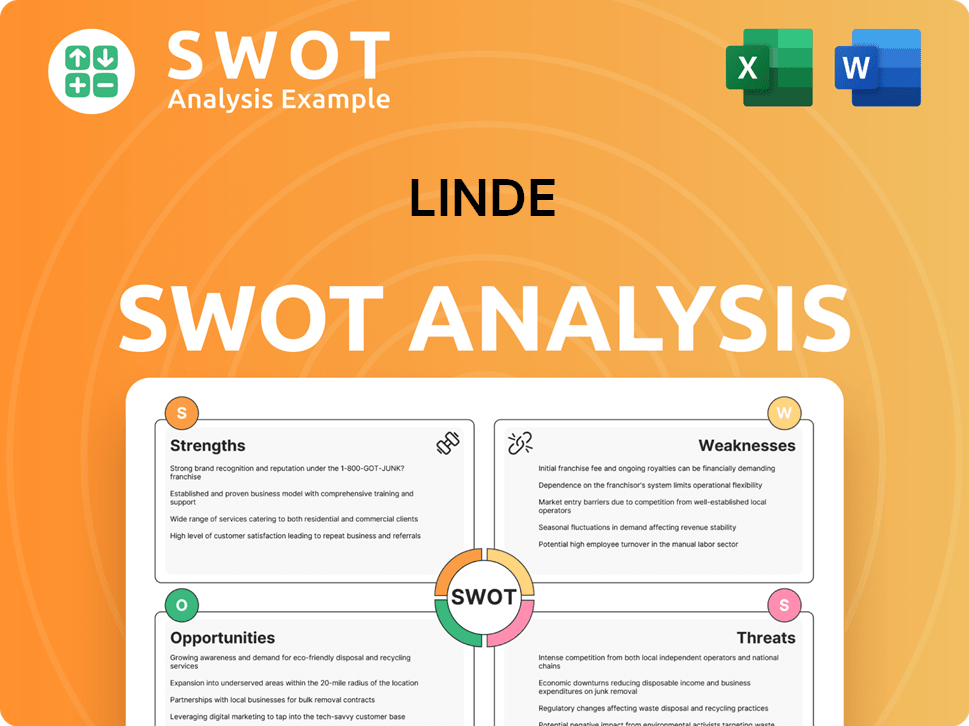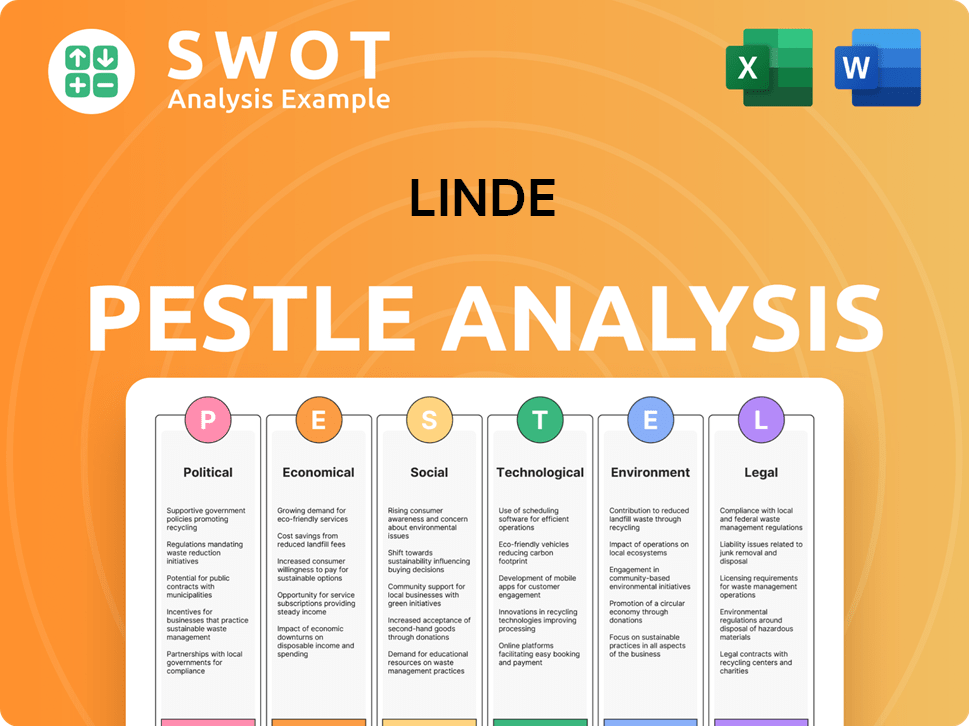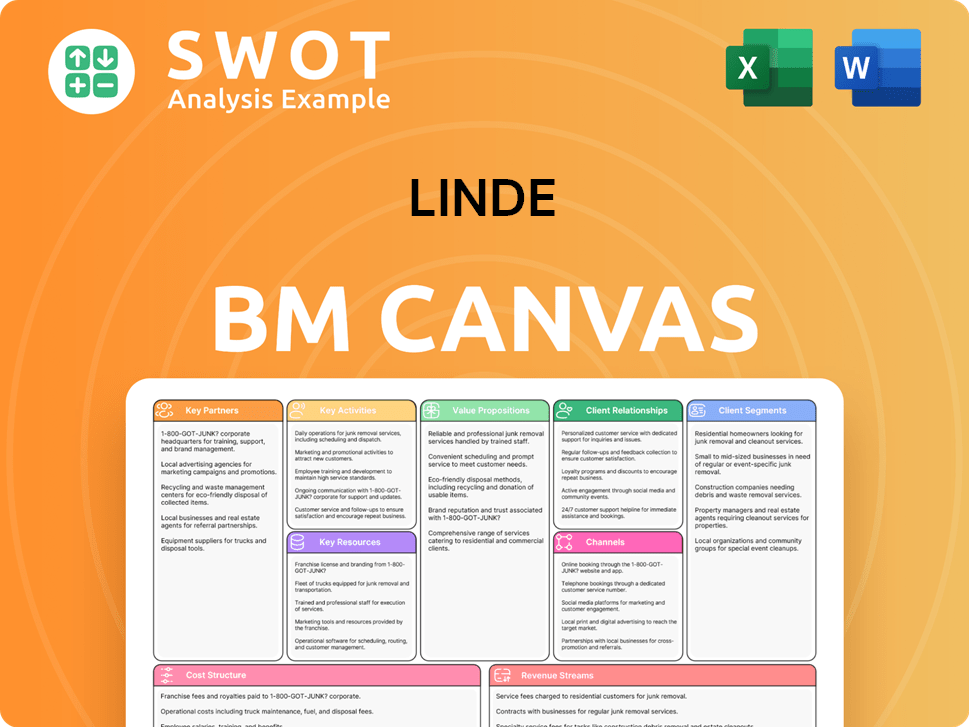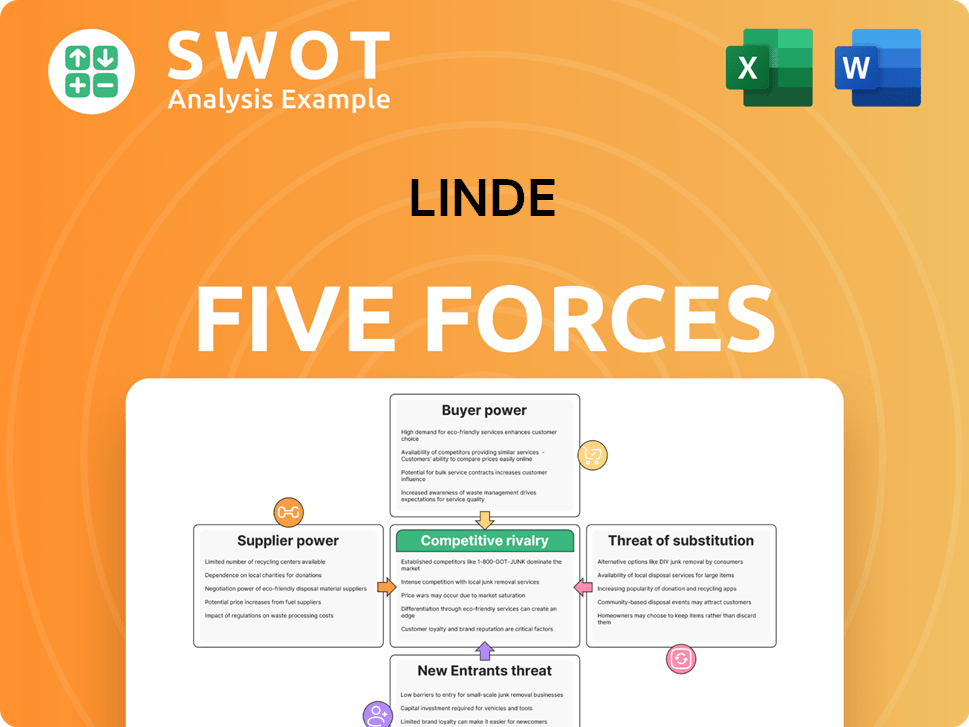Linde Bundle
How Does Linde Navigate the Cutthroat Industrial Gas Market?
The industrial gas industry is undergoing a dramatic transformation, driven by the urgent need for decarbonization and rapid technological advancements. Linde plc, a global leader since 1879, faces a complex and dynamic competitive landscape. Understanding Linde's position, its rivals, and its strategies is crucial for anyone seeking to navigate this evolving sector.

This exploration of the Linde SWOT Analysis will provide a comprehensive Linde market analysis, examining its Linde competitive landscape and identifying its key Linde competitors. We'll dissect Linde's Linde business strategy, evaluate its market share within the industrial gas industry, and analyze its competitive advantages to understand its future prospects in the global market. This deep dive aims to equip you with the knowledge to assess Linde's position and its potential for growth.
Where Does Linde’ Stand in the Current Market?
Linde plc holds a dominant market position within the industrial gases and engineering industry. As of early 2025, it's recognized as the largest industrial gas company by revenue and market capitalization. This strong position is a key factor in understanding the Linde competitive landscape.
The company's core operations involve producing and distributing atmospheric gases like oxygen and nitrogen, along with process gases such as hydrogen and helium. These products are essential for numerous industries. In 2024, Linde reported sales of approximately $33 billion, showcasing its significant scale and market presence. This financial performance is crucial when conducting a Linde market analysis.
Linde's value proposition centers on providing reliable and efficient gas solutions, along with related equipment and services. It serves diverse customer segments, including steelmaking, chemicals, healthcare, and electronics. The company's global reach and diversified product portfolio contribute to its robust market position, allowing it to navigate economic fluctuations effectively.
Linde's estimated market share in the global industrial gases market exceeds 30%, making it a clear leader. This substantial market share highlights its competitive advantage. Understanding this is vital when assessing Linde competitors.
Linde maintains a strong presence across North America, Europe, and Asia. This geographic diversification helps mitigate regional economic risks. This broad presence is a key component of Linde's business strategy.
The company offers a comprehensive range of gases, including atmospheric and process gases, along with related equipment and services. This diverse portfolio caters to a wide array of industrial needs. This is an important aspect of Linde's position in the global industrial gas market.
Linde is expanding into clean energy solutions, particularly hydrogen production and carbon capture. This strategic move aligns with global sustainability trends. This expansion is crucial for Linde's future growth prospects.
Linde's strengths include its large market share, global presence, and diversified product portfolio. These factors contribute to its financial stability and resilience. The company's focus on innovation and sustainability further strengthens its position.
- Leading market share in the industrial gas industry.
- Strong presence in North America, Europe, and Asia.
- Diversified product offerings catering to multiple industries.
- Strategic investments in clean energy solutions.
Linde SWOT Analysis
- Complete SWOT Breakdown
- Fully Customizable
- Editable in Excel & Word
- Professional Formatting
- Investor-Ready Format

Who Are the Main Competitors Challenging Linde?
The Linde competitive landscape is shaped by a global industrial gases market, where it faces competition from both established multinational corporations and emerging regional players. Understanding the strategies and positions of these competitors is crucial for assessing Linde's market position and future prospects. This analysis includes examining key rivals, their competitive tactics, and the evolving dynamics within the industrial gas industry.
Linde's market analysis reveals a highly contested environment, with competitors employing various strategies to gain market share. These include aggressive pricing, technological innovation, expansion of distribution networks, and strategic partnerships. The competitive landscape is further complicated by the emergence of new players and the ongoing reshaping of the industry through mergers and acquisitions. For a deeper dive into how Linde approaches its market presence, consider reading about the Marketing Strategy of Linde.
The primary competitors of Linde include Air Liquide, Air Products and Chemicals, and Messer Group. Each of these companies brings unique strengths and strategies to the market, impacting Linde's Linde business strategy.
Air Liquide, a French multinational, is a direct competitor to Linde, with a comparable size and global presence. It has a strong foothold in Europe and is expanding in healthcare and high-tech industries. In 2024, Air Liquide reported revenues of approximately €33.1 billion, demonstrating its significant market share and competitive strength.
Air Products and Chemicals, based in the U.S., is particularly strong in North America and Asia. It focuses on refining, chemicals, and electronics sectors. Air Products reported sales of $12.7 billion in fiscal year 2024, highlighting its substantial presence and its direct competition with Linde in key markets.
Messer Group, a privately-owned German company, has a significant presence in Europe and China. It often competes on regional projects and specialized applications. Messer's focus on regional markets allows it to compete effectively with Linde in specific areas.
These competitors challenge Linde through aggressive pricing, technological innovation, expansion of distribution networks, and strategic partnerships. Intense bidding wars for large-scale industrial gas supply contracts are common, especially in emerging markets. The Linde market share is directly affected by these strategies.
New and emerging players in the clean energy and hydrogen value chain are disrupting the traditional landscape. They focus on niche markets or offer innovative production methods. The rise of green hydrogen production, with initiatives like the 2024 joint venture, reshapes the competitive dynamics.
Mergers and alliances continually reshape the competitive dynamics. Such activities require Linde to remain agile and strategically responsive. These activities can affect the competitive balance and market share of all major players.
Several factors influence the competitive dynamics within the industrial gas market. These include pricing strategies, technological advancements, geographic reach, and the ability to secure long-term supply contracts. Linde's competitive advantages in 2024 are tied to its ability to innovate and adapt to these factors.
- Pricing: Competitive pricing is crucial for winning contracts, particularly in emerging markets.
- Technology: Innovation in gas production, storage, and application is a key differentiator.
- Distribution: An extensive distribution network ensures reliable supply to customers.
- Partnerships: Strategic alliances can provide access to new markets and technologies.
Linde PESTLE Analysis
- Covers All 6 PESTLE Categories
- No Research Needed – Save Hours of Work
- Built by Experts, Trusted by Consultants
- Instant Download, Ready to Use
- 100% Editable, Fully Customizable

What Gives Linde a Competitive Edge Over Its Rivals?
Understanding the Linde competitive landscape requires a close look at its strengths. Linde's competitive advantages are rooted in its extensive global presence, technological prowess, and strong customer relationships. These factors allow it to maintain a leading position in the industrial gas industry.
Linde's vast operational scale is a key differentiator. With over 800 production plants and a pipeline network spanning 100,000 miles, it ensures efficient and reliable supply worldwide. This infrastructure supports significant economies of scale, which reduces costs and boosts profitability. This extensive network is a critical element of its Linde business strategy.
Linde's focus on research and development is another major advantage. Investments in innovation, such as hydrogen production and carbon capture, enable it to offer specialized gases and equipment. These advanced technologies are crucial in meeting the evolving needs of high-tech sectors. For more insights into Linde's growth strategy, you can read about the Growth Strategy of Linde.
Linde operates a massive global network, including over 800 production plants and a pipeline network stretching 100,000 miles. This extensive infrastructure enables efficient and reliable supply to customers worldwide, creating significant economies of scale. This scale is a key factor in its ability to compete effectively in the industrial gas industry.
Linde invests heavily in research and development, holding numerous patents in areas like hydrogen production and carbon capture. These innovations allow Linde to offer specialized gases and equipment. This technological edge helps Linde meet the evolving needs of high-tech industries and maintain a competitive advantage.
Linde's strong brand equity and long-standing customer relationships, built on decades of reliable service, foster high customer loyalty. This makes it challenging for competitors to penetrate its established client base. These strong relationships are a key part of Linde's ability to maintain its market position.
Continuous process improvements and digitalization initiatives drive Linde's cost competitiveness. These efficiencies enhance its ability to compete effectively in the global market. This focus on efficiency helps Linde maintain its profitability and market share.
Linde's competitive advantages include its global infrastructure, technological leadership, and strong customer relationships. These strengths allow it to maintain a leading position in the Linde competitive landscape. Linde's ability to innovate and adapt to market changes is crucial for its continued success.
- Extensive global production and distribution network.
- Proprietary technologies in gas production and application.
- Strong brand equity and long-standing customer relationships.
- Operational efficiencies through continuous improvement.
Linde Business Model Canvas
- Complete 9-Block Business Model Canvas
- Effortlessly Communicate Your Business Strategy
- Investor-Ready BMC Format
- 100% Editable and Customizable
- Clear and Structured Layout

What Industry Trends Are Reshaping Linde’s Competitive Landscape?
The industrial gas industry, where Linde's growth strategy plays a pivotal role, is experiencing significant shifts. The competitive landscape is dynamic, influenced by global trends such as decarbonization and technological advancements. Understanding these factors is crucial for assessing Linde's market position, potential risks, and future prospects in this evolving environment.
The industrial gas industry is undergoing transformative changes, creating both opportunities and challenges. Factors like geopolitical instability, technological shifts, and the growing emphasis on sustainability are reshaping how companies like Linde operate and compete. This analysis examines the industry's core trends, potential challenges, and the opportunities available to Linde.
Decarbonization is a major trend, driving demand for green hydrogen and carbon capture technologies. Digitalization and automation are also transforming operational efficiencies and customer service. Emerging markets, especially in Asia and Latin America, offer significant growth potential as industrialization continues.
Geopolitical shifts and supply chain disruptions pose ongoing challenges, potentially impacting raw material costs and distribution. Increased regulatory scrutiny on environmental impact and safety standards adds complexity. Continuous capital expenditure and workforce upskilling are needed to keep up with technological advancements.
Linde can capitalize on the growing demand for green hydrogen and sustainable solutions. Expanding into emerging markets offers substantial growth potential. The increasing demand for specialty gases in electronics manufacturing presents another opportunity for expansion and innovation.
Linde is investing in green hydrogen projects and sustainable solutions to meet decarbonization demands. The company is strategically deploying capital towards high-growth areas and investing in product innovations. This includes optimizing supply chains and enhancing remote monitoring capabilities.
Linde's competitive landscape requires agile strategies to remain resilient and capitalize on evolving trends. The company's focus on sustainable solutions and digital integration is crucial for long-term success. Linde's ability to navigate geopolitical risks and adapt to regulatory changes will be essential.
- Focus on green hydrogen and carbon capture technologies.
- Invest in digital transformation for operational efficiency.
- Expand into emerging markets, particularly in Asia.
- Manage supply chain risks and regulatory compliance.
Linde Porter's Five Forces Analysis
- Covers All 5 Competitive Forces in Detail
- Structured for Consultants, Students, and Founders
- 100% Editable in Microsoft Word & Excel
- Instant Digital Download – Use Immediately
- Compatible with Mac & PC – Fully Unlocked

Related Blogs
- What are Mission Vision & Core Values of Linde Company?
- What is Growth Strategy and Future Prospects of Linde Company?
- How Does Linde Company Work?
- What is Sales and Marketing Strategy of Linde Company?
- What is Brief History of Linde Company?
- Who Owns Linde Company?
- What is Customer Demographics and Target Market of Linde Company?
Disclaimer
All information, articles, and product details provided on this website are for general informational and educational purposes only. We do not claim any ownership over, nor do we intend to infringe upon, any trademarks, copyrights, logos, brand names, or other intellectual property mentioned or depicted on this site. Such intellectual property remains the property of its respective owners, and any references here are made solely for identification or informational purposes, without implying any affiliation, endorsement, or partnership.
We make no representations or warranties, express or implied, regarding the accuracy, completeness, or suitability of any content or products presented. Nothing on this website should be construed as legal, tax, investment, financial, medical, or other professional advice. In addition, no part of this site—including articles or product references—constitutes a solicitation, recommendation, endorsement, advertisement, or offer to buy or sell any securities, franchises, or other financial instruments, particularly in jurisdictions where such activity would be unlawful.
All content is of a general nature and may not address the specific circumstances of any individual or entity. It is not a substitute for professional advice or services. Any actions you take based on the information provided here are strictly at your own risk. You accept full responsibility for any decisions or outcomes arising from your use of this website and agree to release us from any liability in connection with your use of, or reliance upon, the content or products found herein.